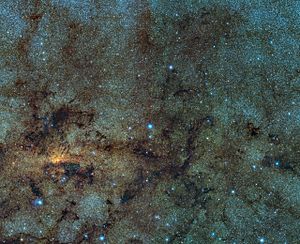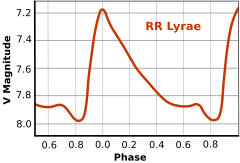RR Lyrae facts for kids


RR Lyrae is a special kind of star that changes its brightness. It's called a variable star because its light isn't always the same. This star is found in the constellation called Lyra, which looks like a harp in the night sky.
RR Lyrae is like the main example for a whole group of stars known as RR Lyrae variables. These stars are very important to astronomers.
Contents
What Are RR Lyrae Stars?
RR Lyrae stars are stars that "pulse." This means they regularly get bigger and smaller, which makes them brighter and dimmer. RR Lyrae itself completes one pulse cycle in about 13 hours and 36 minutes.
During each pulse, the star's size changes. Its radius (the distance from its center to its edge) goes from about 5.1 times the size of our Sun to 5.6 times the Sun's size. Imagine a giant heart beating in space!
Where Are They Found?
You can often find RR Lyrae stars in groups of very old stars called globular clusters. These clusters are like giant balls of hundreds of thousands of stars, all held together by gravity.
Astronomers use RR Lyrae stars to figure out how far away other galaxies are. They are like special "standard candles" in space. This means we know their true brightness, so we can calculate their distance by how bright they appear to us.
How Are They Different from Other Stars?
RR Lyrae stars are usually of spectral class A, which means they are very hot and appear white or bluish-white. Sometimes, they can be class F, which are slightly cooler and appear yellowish-white.
These stars are quite old and don't have as many heavy elements as younger stars. Scientists think they used to be a bit heavier, but they lost some of their mass over time. Now, they are about half the mass of our Sun.
How RR Lyrae Stars Pulsate
RR Lyrae stars pulse in a way that is similar to another type of variable star called Cepheid variables. Both types of stars expand and shrink because of changes happening deep inside them.
However, RR Lyrae stars and Cepheids have different histories. RR Lyrae stars are much older and have less "metal" (which astronomers call any element heavier than hydrogen and helium). They are known as "Population II" stars.
Brightness and Period
RR Lyrae stars are more common than Cepheids, but they are not as bright. An average RR Lyrae star is about 40 to 50 times brighter than our Sun. This might sound very bright, but some other stars are much, much brighter!
Their pulsation period (the time it takes for one full cycle of brightening and dimming) is also shorter than Cepheids. It's usually less than one day, and sometimes as short as seven hours.
Measuring Distances with RR Lyrae
Because we know the relationship between an RR Lyrae star's pulsation period and its true brightness, they are excellent tools for measuring distances. They are especially useful for objects that are relatively close to us, like within our own Milky Way galaxy.
Scientists use them a lot to study globular clusters. They also help us learn about the chemical makeup of very old stars.
Pinpointing RR Lyrae's Distance
For a long time, the exact distance to RR Lyrae itself was a bit uncertain. But in 2002, the Hubble Space Telescope helped scientists figure it out more precisely. They found its distance with only a 5% margin of error.
The Hubble measurements showed RR Lyrae is about 854 light-years away. When combined with information from the Hipparcos satellite and other sources, the best estimate for its distance is about 860 light-years from Earth.
See also
 In Spanish: RR Lyrae para niños
In Spanish: RR Lyrae para niños


